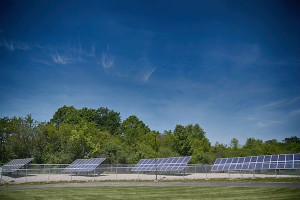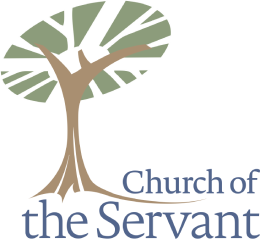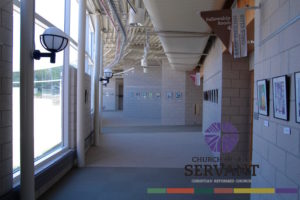Architectural Design Concept: “Dignifying the Ordinary”
Believing that architecture has the capacity not only to facilitate activity but also to communicate the values and vision of its users, Church of the Servant charged its architect, Gunnar Birkerts FAIA of Birmingham, Michigan, with the following:
Express and make tangible the saving grace imparted by God to ordinary people
Express and encourage the diversity of people who come together around the table as a community of believers
Express and encourage the congregation’s commitment to further the participation of all members in the life of the church
Express and encourage joy in servanthood of ‘the children of the light…’
Express and encourage the breadth of talent employed by the congregation toward the advancement of the Kingdom
Express and encourage stewardship in the use of all resources in the realization and ultimate use of the facility
The architect responded with a design which embodies the concept of a village clustered around a town square – the traditional meeting place of a community. Rather than a literal imitation of a small town, the concept is suggested by the choice of materials and the spatial organization.
Thus, the various functional spaces of the church, such as classrooms, offices, kitchen, art and music rooms, are gathered into distinct “houses” which are linked by a fellowship arcade surrounding the “square,” or worship space. In keeping with the concept, the worship platform occupies the head of the “square,” much like a European cathedral or a New England Meetinghouse. This worship center, containing the table, font, and lectern, stands beneath a translucent skylight dome supported by the slender branches of a structural steel “tree.” The image of the tree is reiterated in the design of the pulpit furniture, as well as in the bas relief of the chapel door. As is customary for the congregation, communion is celebrated in the round, ringing the tree, under a canopy of light.
Materials throughout the interior and exterior of the building are simple, common materials: exposed steel, burnished concrete block, gypsum drywall, clear birch hardwood and plywood, standard residential windows, textured plywood siding. These unassuming and unadorned materials are ‘dignified” in their employment, coming together with grace and care to glorify God and serve His people.
Colors in the interior are muted, the better to support seasonal liturgical banners and paraments, as well as changing exhibits of contemporary ecclesiastical art executed by members and friends of the congregation. In contrast, colors on the exterior are striking: shades of forest green, golden brown, periwinkle blue, ash gray, and mulberry purple. These colors are derived from the foliage and wildflowers sown on the site, the bark of trees, native grasses, the sky…and are echoed in the banners lining the entry drive. In addition to helping to break down the considerable bulk of the building mass, these colors are a celebration of our diversity. They boldly declare to visitors and the community that we, the Church of the Servant, are people of a covenant promise which leads, ultimately, to joy.
Stewardship Initiatives

COS Founded
Church of the Servant CRC was formally born on Sunday, Sept. 9, 1973. Its first minister, John Vriend, was installed a year later and served COS through Pentecost 1982. A year later, on Pentecost 1983, Jack Roeda became its second pastor.
Building Committee Formed
After meeting in the Seymour gym for 13 years, the congregation decided to put down roots and construct a building. A building Committee was formed in 1986
1973-1994
After a series of four locations–Oakhill Presbyterian Church, the basement of Creston-Mayfeild Christian School, and the gymnasiums of Mulick Park School and Seymour Christian School–the congregation decided to put down roots and construct a building.
Ground Breaking 1992
Ground Breaking at 3835 Burton SE.
First Service in Current Building 1994
Fist Service in Current Building was held in January, 1994
Addition Built 2006
Our new addition, including classrooms and the “Artery” was completed in February, 2006
Solar Panels installed – Sept. 2015
Solar Panels installed on the North End of the property
The ARTery
Future Facility Projects
The following list of projects
• Replace roof over the 2006 addition with a white thermal plastic roof
• Convert all indoor and outdoor lighting to LEDs
• Replace Fellowship Rooms’ stage lighting with an LED system
• Expand the Building Automation System to include all of the HVAC and Lighting systems, and create individualized controls for each office and Fellowship Rooms
• Expand the community garden
• Install low-flow toilets and faucets
• Install hand dryers in bathrooms
• Install a water bottle filling station in the ARTery
• Plant more Native
• Convert HVAC systems to Geothermal
• Build additional storage space
• Install new street signs and landscaping
• Replace remaining wood exterior doors and windows
• Build a new larger, better located and functioning Kitchen
• Expand Children’s and Youth Center
• Build pole barn for vans and tractors, expand Boys & Girls Clubs’ workshop in
• Implement Memorial Garden master plan
• New sanctuary seating
Facility Rentals
At present, we are not renting the church facility outside of our congregational needs. If you have questions, you may contact Monica Smith, Church Administrator.
Click and drag within the frame below to view our sanctuary space


